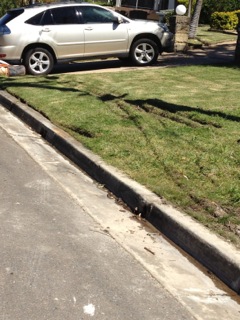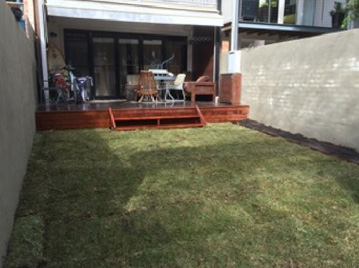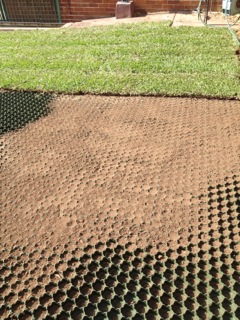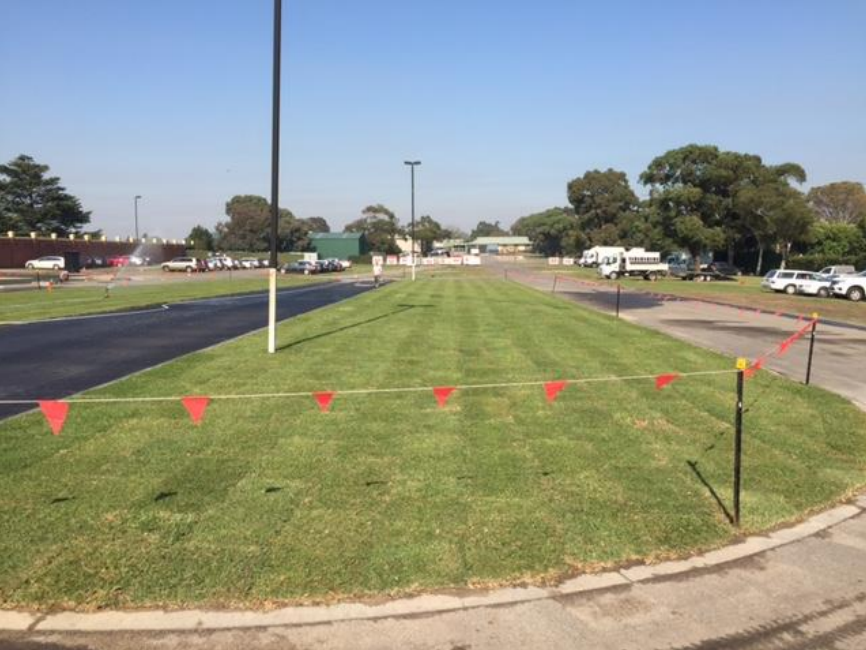Why would you want to park on your grass?
Parking space is at a premium across a lot of Australian cities, and will only get worse with ongoing high-density infill development. Reinforced grass parking areas are a great way to improve parking options. You can create multi-use areas for temporary parking or provide parking on sites whe
re council landscape ratios are tight . The wider community are focusing more on sustainability throughout design. Reinforced grass parking is a great alternative landscape solution to traditional concrete parking.
Water Sensitive Urban Design (WSUD)
The CSIRO ebook on WSUD states: “Water sensitive urban design offers an alternative to the traditional conveyance approach to stormwater management. It seeks to minimise the extent of impervious surfaces and mitigate changes to the natural water balance, through on-site reuse of the water as well as through temporary storage.”. A grass parking area or driveway is a great way to reducing hard paved areas and improve stormwater management on your site.

Urban Heat Island Effect
The Urban Heat Island Effect has been identified as a critical climate issue, particularly in areas such as Western Sydney. Temperatures are predicted to increase because of the changing land use from grassland to low or medium density development. As a result, councils such as Parramatta Council are implementing cooling strategies such as urban greening or shading to reduce the impacts. This will create cool zones which are more comfortable for their residents. You can create your own cool zone at home by replacing concrete with a grass parking area and planting to provide shade.
The National 202020 Vision aimed for 20 percent more green spaces in urban areas by 2020. Additionally, the National Water Initiative has identified the need for greener urban development. Grass surfaces can play a significant role in achieving these goals.
What are the benefits of grass parking areas?
If 2020 taught us anything, it was that we need our homes and local communities to be places we enjoy. Places that help us unwind. Green spaces and nature are good for our health, but never before have we needed direct access as much as we did in 2020. Green areas ale help our kids development by incentivising them to get them away from the dreaded screen and spend time outside.
Integration of a grass parking are into your home or landscape design could help improve your access to green space. A range of other benefits include:
- More space for kids to play when the parking is not in use.
- Additional parking areas which improve development landscape ratios.
- Improving stormwater infiltration can improving the health of your surrounding soil, reducing the amount of rainfall runoff and potentially reducing downstream flooding. It may also help recharge and maintaining natural groundwater aquifers.
- Permeable parking may give trees the space they need to grow to full size. A porous surface lets vital air and water migrate down to the rooting zone. This can help with your planting and allow a living tree canopy above to improve your green outlook.

Are there any downsides to parking on the grass?
Soil compaction by vehicle loads
Healthy grass needs healthy aerated soil. The loads from vehicle traffic, or even high foot traffic, can result in soil compaction which will reduce the amount of air and water that reaches the root zone for your grass. Compaction also stops water infiltration and increases runoff. Compaction occurs soil is compressed and air and water are pushed out. This makes the soil dense and restricts root movement, infiltration, drainage and air circulation. Then your grass dies!
Grass Pavers are designed in a hollow honeycomb or square pattern, that provides support to the root zone and protects the grass from the impacts of soil compaction. Systems are typically laid over gravel, sand, or in some cases turf underlay. The extent of support, and need for a heavily compacted sub-base, depends on the loads being applied and the design of your selected grass paver. Some superior options act as weight bearing blocks and are strong enough to carry vehicle loads empty. Others rely on the soil within and may provide less protection to the grass, or be less durable in the long term.
Wet weather and Ruts
When it rains the soil gets saturated and loses its strength. If you drive on your grass when it is saturated you will cause ruts in your grass. This results in unsightly ruts, bogged cars and damaged grass that needs to be repaired. A well installed reinforced grass solution will prevent your wheels slipping and distribute loads to the underlying soil. Reinforced grass will stop you getting bogged and prevent wheel ruts.
Grass is a living plant, and needs sunlight
Anyone who has left something on the grass for a few days knows the yellow of dying grass. The unfortunate reality is that if you park on your grass permanently, the grass will not get any sunlight and will die. But how often would you be at home parking on the grass all day? Can your grass get enough sunlight while your away from home?
General consensus is that common couch grass requires 6-7 hours of direct sunlight a day to survive, but there are other options which require much less. Lawn Solutions Australia states that Sir Walter DNA Certified can thrive with as little as 2-3 hours of direct sunlight daily. Sir Grange zoysia grass is another option which can thrive with little as 2-3 hours sun daily. We recommend speaking to a specialist turf supplier who can recommend a variety which is suited to your area.
How do Grass-cel porous pavers help with grass parking?
Grass-Cel® Porous Turf Pavers can help you create a reinforced grass parking area capable of supporting the heaviest of loads. The design utilises the most efficient shape in nature, the Hexagon. Hexagons are often seen in nature: bee hives are the common example, but definitely not the only. Basalt columns and insect eyes also form hexagonal patterns. While we’re getting distracted by Hexagons, this article explores more weird and wonderful examples of Hexagons in nature.
Now, why was the Hexagon selected for the design of Grass-Cel® Porous Pavers? Well, the answer is one of efficiency. Hexagons of equal size fit together in the most efficient way across a surface, and results in the minimum perimeter distance of any shape. That’s all a bit mathsy… but it means we can increase the wall thickness and subsequently the strength of the block. As a result, Grass-Cell® is one of the strongest weight bearing grass pavers on the market.

Prevents soil compaction and ruts
Grass-Cel® is made of hexagonal cells that provide structural rigidity to the block, allowing vehicle loads to be isolated from the grass. The flat base transfers traffic loads efficiently into the sub-grade, just like a typical paver. These two features combine to prevent soil compaction and reduce the need for heavily compacted sub-grade for light vehicle applications. Grass-Cel® Grass Pavers prevent wheel ruts, because they provide a stable base for your wheels in wet weather.
Promotes healthy grass
The base and sides of the cells have holes within them, which allow the roots to grow through into the underlying soil and also let air, water and nutrients reach the roots. Runners can move laterally across cells too, through the small groove at the top of the cell. The design has carefully considered the way grass grows to protect your lawn and provide the best environment for success under vehicle loads.
Environmentally Friendly and Certified
Grass-Cel is the only Grass Paver to be certified by Good Environmental Choice Australia. Other products are similar, but none provide the combination of weight bearing, strength, and environmental certification that you can get from Grass-Cel® Porous Turf Pavers.
Longevity and Maintenance
One of the great aspects of using grass as a paving area is that it’s a living plant and will re-grow over time. The longevity and strength of grass pavers means that the pavers themselves are set and forget. Grass pavers need little maintenance once they are laid and will last significantly longer than a concrete slab. A sealed driveway will eventually crack and need to be replaced which adds to maintenance and repair costs. Grass pavers support the grass which grows in them and allow some movement. Since the finish is grass or pebbles there are no surface to cracks.
The first driveways which had Grass-Cel® installed are still in operation today, over 40 years later. That speaks to the quality of the product. We have even had clients contact us for extra pavers to supplement old stock which was excavated, washed off and reused for a new installation! The only upkeep required will be that of the lawn, but due to the protection provided by a quality grass paver issues of wear and tear and disease outbreaks are either a non-event or super easy to maintain. You’ll still be able to use your mower like normal!
What grass should I use?
Grass breed and types
Most grasses available on the market will be suitable for a grass parking or driveway area, providing they are well maintained. We have seen great results with Sir Walter, Zoysia, Kikuyo and Couch. The best bet is to contact your local turf supplier and speak to them about the best option for your specific climate and application.
Don’t forget that the grass paver only protects the root zone, the grass leaf will still be exposed to the traffic as it sits above the paver. The leaf can be damaged if you have heavy traffic. Water, fertiliser and sunlight are critical to growing a strong and healthy grass which can withstand this damage and look beautiful for years to come.
Seed or Turf?
The best way to grow the grass is to sprinkle seeds into the cells. It’s the slowest way to grow the grass, but your grass will have a deeper root system and be hardier under traffic loads. If you want instant gratification you can use pre-grown turf rolls which give you a grass parking area by sunset. Another option if you live in an arid climate, have a lot of shade, or need to park on the area regularly is to fill the cells with gravel or crushed rock. This will achieve a lot of the infiltration benefits discussed and can look amazing with a specialty pebble.
Maintaining Healthy Grass
If you park on your grass you need to maintain your lawn. Fortunately, our friends at Lovegrove Turf Services have published a great guide on how to care for your lawn. In this guide they cover the key aspects of lawn maintenance such as watering, fertilising, mowing and more.

Caufield Racecourse Carpark Grass Parking
Victoria, Australia
Grass-Cel was installed to reinforce grassed parking areas as part of the redevelopment of Caufield Racecourse Members Carpark in 2018. Evergreen Turf were engaged by the Melbourne Racing Club to redevelop the members carpark and used Grass-Cel® Porous Grass Pavers as part of the installation of overflow parking for bus parking. The project was successfully completed and continues to be used today.